Please Take Note: This is a review of the final game, but it might change slightly based on the success of the Kickstarter campaign. The game is being reviewed on the components and the rules provided with the understanding that “what you see is not what you might get” when the game is published. If you like what you read and want to learn more, we encourage you to visit the Kickstarter campaign. Now that we have all that disclaimer junk out of the way, on with the review.

The Basics:
- For ages 12 and up (publisher suggests 14+)
- For 2 to 4 players
- Approximately 90 minutes to complete
Geek Skills:
- Active Listening & Communication
- Counting & Math
- Logical & Critical Decision Making
- Reading
- Strategy & Tactics
- Semi-Cooperation
- Hand/Resource Management
- Auctioning, Bidding, & Trading
- Worker Placement & Area Control
Learning Curve:
- Child – Moderate
- Adult – Easy
Theme & Narrative:
- Control the city one vote and one building at a time
Endorsements:
- Gamer Geek mixed!
- Parent Geek mixed!
- Child Geek rejected!
Overview
American moral and social philosopher, Eric Hoffer, said “The only way to predict the future is to have power to shape the future.” In this game, players seek to shape the city to match their vision of the future. Along the way, they must work with their opponents and make compromises, but they should never lose sight of their goals.
Redneck Invasion, designed and to be self-published by Richard Gurley, will reportedly be comprised of 1 game board, 4 Player mats, 1 Scoresheet, 52 Business/Culture tiles (13 per player), 8 Residential tiles, 40 Building Permit cards, 50 Event cards, Cash (in the values of $1, $5, and $20), 55 Player meeples (13 per player, 3 Neutral), 8 Player pawns (2 per player), and 1 Population pawn. As this is a review of a prepublished game, I cannot comment on the component quality. Not included with the game, but necessary to play, is a pen or pencil to records the scores on the Scoresheet.
Your City, USA
To set up the game, first place the game board in the middle of the playing area and within easy reach of all the players.
Second, place the Residential, Neutral, Business, and Neutral Cultural tiles on the game board spaces that represent different sections of the city. This can be done randomly or by design (allowing players to control the type of game they want to play). A suggested first-time game placement is provided.
Third, place the Population pawn on the Population track in the 10k box value for a 2-player game, the 20k box value for a 3-player game, and the 40k box value for a 4-player game.
Fourth, place 1 Player pawn for each player on the start of the Mojo track that is found on the border of the game board. Determine the first round player order and place the second Player pawns on the Turn Order track.
Fifth, give each player a Player mat, matching meeples, Business, and Cultural tiles.
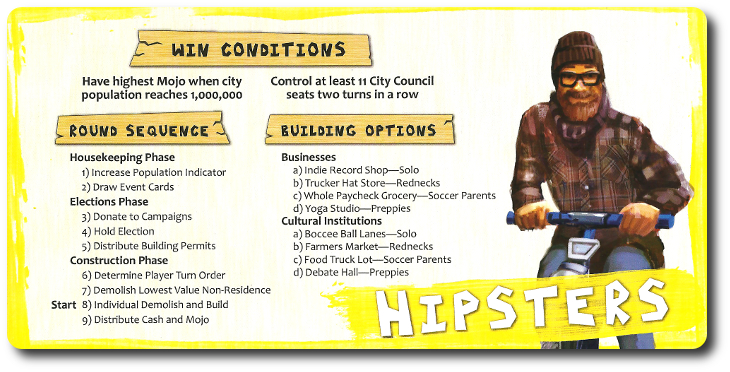
Sixth, give each player 3 Building permit cards, $10 worth of Cash, and a Scoresheet.
Seventh, place all the remaining Building Permit cards and Cash off to one side of the game board. This is referred to as the “Bank”. Shuffle the Event cards and place them face-down next to the Bank. Next to the Bank, place all Neutral meeples, Business tiles, and Cultural tiles. These do not belong to any player.
A Clash of Cash and Culture
Redneck Invasion is played in rounds and turns. Rounds are kept track of using the Population track. The total number of rounds is dependent on the number of players (ranging from 7 to 9 rounds). The game can end early, however, if a player is able to meet the Political victory condition. A game round is summarized here.
Phase 1: House Keeping
The House Keeping phase is comprised of 2 steps.
Step 1: Increase Population
The Population pawn is moved to the next highest population value on the Population track.
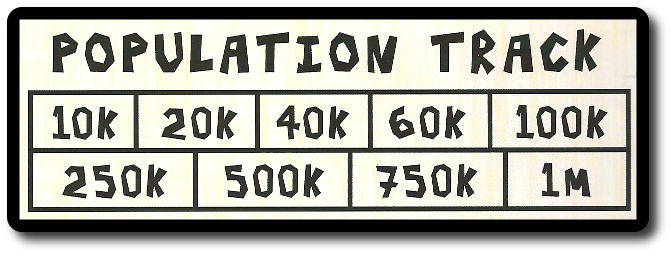
Step 2: Draw Events (and Possibly Play Them)
Each player draws 1 Event card. Event cards can be played at anytime during the game, including when they are first drawn. If players do not play them, they remain with the player face-down. No more than 3 Event cards can be kept at one time. This means a player cannot draw a new Event card if they have 3 already until they discard or play an Event card.
When Event cards are played, the player announces it and reads the Event card’s effects. The Event card is immediately resolved and placed face-up in the Event card discard pile.

Phase 2: Hold Elections
The second phase of the game focuses on holding elections and attempting to get as much political clout as possible.
Step 1: Campaign Donations
Each player counts their Cash and determines how much they want to donate to the local political battles. The value is written on the back of the player’s Scoresheet and remains secret. Players cannot donate more Cash than what they have in their possession.
Step 2: Hold an Election
Once all the players are done writing down their campaign donation, they are simultaneously revealed. The election for City Council seats now commences. There are 12 seat in total that are up for grabs and a player must donate at least $1 if they want a chance to grab some of the political power.
- 6 City Council seats are given to the player who provided the largest donation.
- 4 City Council seats are given to the player who provided the second largest donation.
- 2 City Council seats are given to the player who provided the third largest donation (if playing with only 2-players, the 2 City Council seats become Neutral).
If there is a tie, the City Council seats are distributed as evenly as possible between the players. All donated Cash is returned to the Bank.
The remaining 9 seats on the City Council are given to the players with the most Mojo (term used to represent cultural influence).
- 5 City Council seats are given to the player with the most Mojo.
- 3 City Council seats are given to the player with the second most Mojo.
- 1 City Council seat is given to the player with the third most Mojo (if playing with only 2-players, the 1 City Council seat becomes Neutral).
Again, ties between players will result in an even distribution of available seats, with extras going to the Neutrals.
To help keep track of which player controls which seats, the City Council track should be used. Players place their meeples in the correct space.
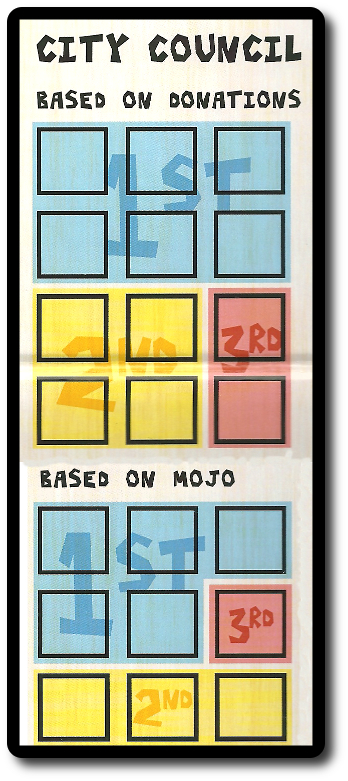
Step 3: Building Permits
Now that the City Council is full of representatives, it’s time to use that political power to give out Building Permits to friendly parties. Each player is given 1 Building Permit per seat on City Council they currently control. Any player can sell back their unwanted Building Permit cards to the Bank for $2 a piece. Caution should be taken before doing so. Building Permits are only made available from the City Council. A player cannot buy Building Permits directly. However, players can purchase Building Permits from an opponent, but the price is not fixed.
Phase 3: Construction
The city is about to grow, and with the player’s influence, the city’s culture and financial well-being is about to change. Players build in different sections of the city. Each section has a different number of “blocks”. Each block has 4 square “lots”. The Building and Cultural tiles are placed within these blocks and must fit within the squares.
The property value in each section is different and the value increases based on how much is built. The Boondocks (B) are the biggest section, the cheapest to build in, and has the weakest return. The Suburbs (S) are smaller than the Boondocks, costs more, but generally provides a healthy return on investment. Midtown (M) tends to be expensive to build in, but players should have no problem with a return on an investment. Finally, Downtown (D) is the most expensive to build in, but players will always get a return on their investment. A chart is provided on the game board to help players quickly determine the cost and payout based on the section and the number of lots owned.
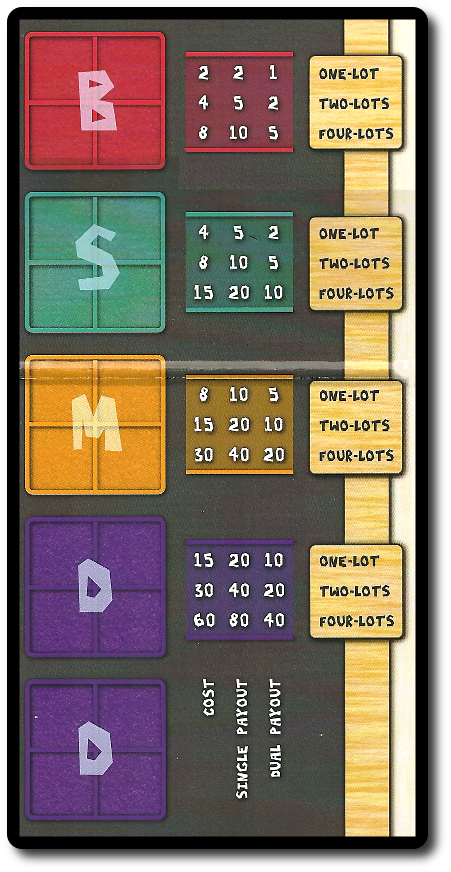
Step 1: Determine Player Order
The turn order is determined by the number of seats a player has on the City Council. The player with the most City Council seats goes first, followed by the second highest, and so on. Record the player turn order by using the Turn Order track.
Step 2: Down With the Old
Determine which non-Residential tile has the lowest value and remove it from the game board. The tile can belong to a player or a Neutral. A tile’s value is determined by the cost to build it, which is determined by the value of the lot on which the building was constructed. The cost can be found on both the game board and the player mats.
If there are 2 or more tiles that tie for the lowest value, the player who is first in the turn order sequence gets to decide which tile is removed.
Step 3: Up With the New
In turn order sequence, each player can build to the city. In order to be able to build, the player must have 1 or more Building Permit cards, the Cash on hand to pay for the building’s construction, and the land to build upon. Players can decide to build on their own or build alongside an opponent.
There are 3 types of construction methods available to the player.
- Build: If building a new tile, the player must have 1 Building Permit card per the number of lots the tile will cover (small, medium, and large-sized lots that take 1, 2, and 4 spaces) and the Cash to pay for the lot. A player can team up with an opponent to cooperatively build on adjacent spaces by offering to provide all the Building Permits, all the Cash, or any other mutually agreed upon details.
- Expand: If there is available space in a lot that already has a player’s tile, they can expand the building by adding another tile. However, the tile must be of the same type (Business or Cultural). The player must have the correct number of Building Permits and have the Cash on hand.
- Demolish: The player can remove tiles from a lot if they no longer want those tiles on the game board. Demolishing does not come cheap, however, and the player must give 1 Building Permit to the Bank per tile being removed, pay the owners of the tiles their Cash value, and then pay the Bank the cost of the tiles. Once all the payments have been made, the player must then replace it with tiles that belong to them and is of the same type (you cannot demolish a Cultural tile and replace it with a Business tile). The tile must also be the same size or larger.
Players can negotiate any deal they like in the game, trading cards, cash, and favors with opponents. All deals must be made openly and at the gaming table. Other players can break in while listening, sabotaging the deal if they think it’s in their best interest. Good negotiation skills are key, as is a solid Poker face. This is not a cooperative game, however, and players only work together if it’s in their best interest to do so.
This ends the player’s turn. They can continue to build, expand, and demolish out of turn, but only if an opponent wants to partner with them.
Step 4: Reaping the Rewards
After all the players have had their turn, the players are paid and their Mojo is evaluated.
- Each player receives Cash equal to the earnings generated by their Business tiles. The amount of Cash given is listed on the side of the game board.
- Each player receives Mojo points equal to the cultural value of their Cultural tiles. Points earned are recorded using the Mojo track.
In addition, plays may give the Bank $5 at anytime during the game to increase their current Mojo score by +1.
This ends the game round. A new game round now begins unless a player has won the game.
Winning Over the People
There are 2 ways a player can win Redneck Invasion.
- Political Victory: Be the first player to control 11 or more City Council seats at the end of the Election phase two times in a row.
- Cultural Victory: Be the player with the greatest Mojo value at the end of the round with a population of a million people.
Game Variants
A small number of game variants are provided that can be used by those who like to change the original game. Each is summarized here.
Alternate Set Up
The tiles can be used during set up to establish different initial starting political and cultural values at the start of the game. By mixing and matching, players can alter the current state of the city that will change the way in which they play the game.
Alternate Cost an Payouts
Instead of using the printed cost and payout values, select different values. This changes not only the values of the tiles, but their general usefulness to the players.
Alternate Victory
Include a new victory condition before playing. The game is won by the first player to own all the most valuable buildings.
To learn more about Redneck Invasion, visit the Kickstarter campaign.
Final Word
The Child Geeks had a hard time with this one. The average length of a first game clocked in around 2 hours. During that time, the Child Geeks learned the basics easily enough and then got lost in the details that govern the logic behind building and demolishing. The only aspect of the game that came naturally was knowing when to play or when to hold Event cards. Everything else, from negotiating with a possible building partner to capitalizing on political power, didn’t come easy. According to one Child Geek, “I understand what this game is about, but I’m having a hard time picturing in my mind how to go about scoring points.” Another Child Geek said, “After playing this, I’d rather play Monopoly. That’s a game I understand.” When the games were over, the Child Geeks voted to rejected Redneck Invasion and went to play something else.
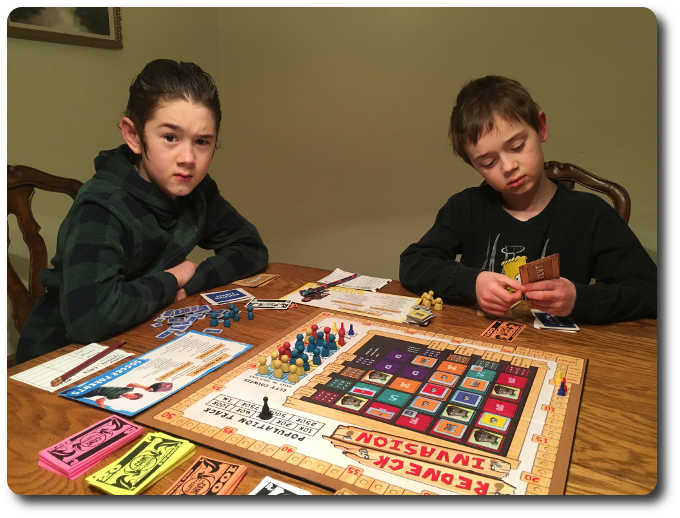
Game play went slowly for the Child Geeks, but Event cards were always resolved quickly
The non-gamer and casual Parent Geeks didn’t enjoy the game as much as I thought, finding it to be a bit slow and more detailed than they normally like. According to a casual Parent Geek, “I like the game well enough, but it feels too heavy and the choices you have to make can be seem complicated.” None of the Parent Geeks had problems learning and playing the game, however. The only time the game slowed down was when players built, expanded, and demolished. One Parent Geek who very much enjoyed the game said, “This is a fun game. I like how you have to consider all the different ways to spend your money and the need to keep friends in political positions. Very realistic.” When the votes came in, the Parent Geeks were mixed. The casual and non-gamers gave Redneck Invasion a pass, while the more skilled and experienced Parent Geeks praised the game.
The Gamer Geeks liked many aspects of Redneck Invasion, but not necessarily how the game was going about it. According to one Gamer Geek, “I’m loving that we have to buy political favor to do business and that we have the freedom to build and trade. What I do not like is that players can take out your tiles just because they have more money.” Which is to say, it became obvious that the player with the most money controlled pretty much everything. As one Gamer Geek put it, “If you have the cash, you can do whatever you want in this game, including knocking down other player’s buildings.” Not that the Gamer Geeks minded, but they thought that such power was odd when it could not be blocked or directly addressed via a counter move. After a number of games, the Gamer Geeks were mixed when it came to their endorsement. About half of the Gamer Geeks felt that Redneck Invasion needed more work. The other half thought that the game did several things well enough to make it entertaining.
Redneck Invasion is a misleading game. First, its title would suggest something goofy, dealing with stereotypes coming down from the hills and setting fire to Whole Food stores. Second, the game doesn’t look all that complicated when you approach it. In truth, Redneck Invasion has nothing to do with cultural or economic classes (other than the Player mat that does not influence the game). This is a game that’s steeped in politics, economics, and negotiation. It’s not a forgiving game, but it does reward the shrewd and the bold.
The cons found in the game by our playing groups focused on the time it took to play it and the complexity of the game play. The Gamer Geeks even suggested that game’s depth and tactical play needed refinement before it was a game they would want to play. And yet, this game is very playable, enjoyable, and challenging. I am not certain what is missing from the Gamer Geek’s perspective, but I do agree with the Child Geeks and the Parent Geeks. Redneck Invasion is not an easy or light game.
I liked Redneck Invasion. It gives you room to “tinker” with the mechanics and work different paths to victory. I found working towards the Political victory to be the most enjoyable, as you have to be actively involved not only in the game, but also with your opponents. Making deals, cooperatively building in areas, and taking advantage of opportunities to grab more political power. I found the Cultural victory to be exceedingly boring and altogether unnecessary. I would have preferred it as a tie breaker or removed completely. This victory condition requires players to play the game to the very end and look a the Mojo track to determine the winner. This is not a bad thing, but it lacks much of the Political victory’s depth, strategy, and tactical finesse that is at the core of the game.
Luckily for the players, one victory condition is not favored above another and both are open for use. Players who want a more in-depth and involved game will naturally gravitated towards the Political victory and play the game accordingly. Those who like to just play quietly and rarely interact with opponents will focus on the Cultural victory. In all cases, both player types will converge in the city and at the City Council. No matter how you look at it, players must interact on certain levels. This is both a good thing and a bad thing, as it can stifle a player’s ability to get things done or put them in a position where they can leverage their goals.
If you enjoy games where economics, politics, and culture converge, then do play Redneck Invasion.
This is a paid for review of the game’s final prototype. Although our time and focus was financially compensated, our words are our own. We’d need at least 10 million dollars before we started saying what other people wanted. Such is the statuesque and legendary integrity of Father Geek which cannot be bought except by those who own their own private islands and small countries.



